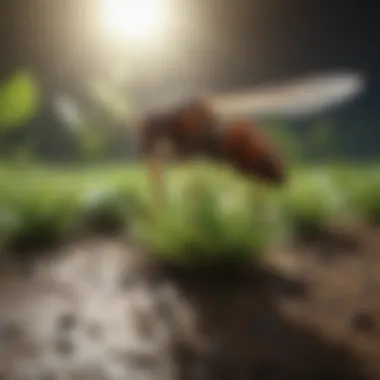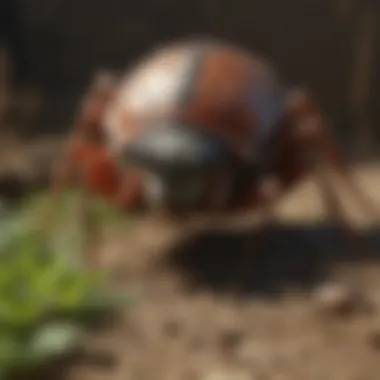Insecticides for Effective Grub Control Solutions


Intro
Effective pest control is a crucial aspect of modern agriculture and horticulture. Among the various pests that threaten crops, grubs hold a notable place due to their rapid proliferation and potential to cause significant damage. Understanding insecticides that specifically target grubs is vital for farmers and horticulturists aiming to safeguard their plants while maintaining sustainability. This overview will explore the insecticides available for grub control, evaluating their composition, effectiveness, application methods, and potential environmental impacts.
Grubs, which majority are beetle larvae, can undermine the health of plants by damaging roots and stunting growth. By utilizing specific insecticides and integrated pest management strategies, it is possible to manage these pests effectively. Learning about the current trends in agriculture and horticulture helps in making informed decisions regarding pest management practices.
Current Trends in Agriculture and Horticulture
Overview of Recent Innovations
Recent developments in agriculture show a growing emphasis on innovative insecticides designed to tackle grubs specifically. These innovations often include biological insecticides which utilize pathogens or fungi to kill grubs without harming beneficial insects. Other products contain systemic insecticides that are absorbed by plants, making them toxic to pests upon consumption. Understanding these innovations provides insight into effective grub control strategies.
Sustainable Practices Gaining Popularity
Farmers increasingly recognize the importance of sustainable practices when it comes to pest control. Integrated pest management (IPM) is becoming a standard approach, combining cultural, biological, and chemical methods to manage pest populations while minimizing environmental impacts. Practices such as crop rotation and maintaining healthy soil biodiversity promote a more resilient ecosystem, reducing the reliance on chemical insecticides.
Essential Farming Techniques
Soil Health Management
Healthy soil is the foundation of robust plant growth. Practices such as cover cropping, reduced tillage, and organic amendments contribute to improved soil structure and nutrient availability. This, in turn, fosters healthier plants that can better withstand pest pressures, including grubs. Soil health management is integral to any strategy aimed at controlling pests effectively.
Pest and Disease Control Strategies
Effective pest control requires a comprehensive knowledge of potential threats. Grubs can be managed through several strategies, including:
- Monitoring pest populations: Regularly inspecting crops for signs of grub activity helps in making timely decisions regarding intervention.
- Cultural practices: Adjusting planting dates and practicing crop rotation can disrupt the life cycles of grubs.
- Chemical applications: Choosing the right insecticides and applying them at the optimum time is critical for effective grub management.
The choice of insecticides can significantly influence both yield and environmental health. It is important to evaluate their long-term effects and potential resistance build-up.
Tools and Technology in Farming
Overview of Advanced Farming Tools
Technological advancements continue to transform the agriculture industry. Tools such as precision application equipment allow for targeted insecticide application, minimizing waste and environmental exposure. Drones equipped with imaging technology can monitor pest populations and plant health, providing valuable data for effective decision-making.
Case Studies on the Use of Technology
Examining real-life examples can provide insights on effective berug control. For instance, a midwestern farm implemented drones to identify grub hotspots before applying targeted insecticides. This method led to a substantial reduction in overall insecticide use and improved crop health. These case studies highlight the interplay between technology and pest management.
Understanding the range of insecticides available for grub control, coupled with ongoing innovations and sustainable practices, can lead to better management decisions. This comprehensive overview aims to equip readers with the knowledge necessary for informed pest management in agricultural contexts.
Understanding Grubs and Their Impact
Grubs, often the larvae of beetles, are notorious for their propensity to damage lawns, crops, and ornamental plants. The significance of understanding grubs extends beyond mere pest control; it involves grasping their biology, behavior, and the broader implications of their presence in ecosystems. Farmers and gardeners must assess the specific types of grubs in their areas, as well as their lifecycle and feeding habits. Understanding these elements assists in developing effective management and control strategies.
Types of Grubs
Grubs can be categorized primarily based on their species, with the most common being the larvae of Japanese beetles, European chafers, and June beetles. Each species exhibits distinct characteristics. For instance, Japanese beetle grubs typically are white with a distinctive "C" shape, while June beetles are often recognized by their brownish coloring. Understanding the type of grub infestation is critical for selecting the right insecticide and determining how best to apply it. Notably, the behaviors and preferences for feeding sites can differ, influencing the effectiveness of any treatment applied.
Lifecycle and Behavior
The lifecycle of grubs typically spans three stages: egg, larva, and adult. Adult beetles lay eggs in soil during the summer months, and these eggs hatch into larvae that begin to feed on roots of grass and other plants as they grow. This feeding activity can lead to significant damage, particularly in lawns where grass roots are vital for overall health. Furthermore, understanding the behavior of grubs, such as their burrowing habits and feeding times, can aid in timing insecticide applications for maximum effect. Research indicates that targeting grubs during their early larval stage, often in late summer or early fall, can increase control success.
Economic and Ecological Consequences
The presence of grubs in agricultural settings can result in both economic losses and ecological disturbances. Lawn care and agricultural production can incur significant costs due to grub damage, often necessitating remedies like insecticide applications or reseeding. Additionally, heavy infestations can lead to soil erosion, as damaged plants fail to hold the soil structure together. From an ecological standpoint, the use of insecticides to control grub populations must be balanced with potential impacts on non-target organisms. The application of specific insecticides can inadvertently affect beneficial insects and soil health, emphasizing the importance of integrated pest management approaches.
Understanding grubs is essential for effective agricultural management. Recognizing their types, lifecycle, and the consequences of their presence allows for informed decisions that promote crop health and sustainability.


Insecticides Overview
In the landscape of pest management, insecticides play a pivotal role, especially when it comes to controlling grubs that threaten both agricultural and horticultural initiatives. Effective insecticides can significantly reduce the damage caused by these pests, leading to healthier crops and better yields. Thus, understanding the various types of insecticides and their applications is crucial for any farmer or gardening enthusiast.
Definition and Functionality
Insecticides are chemical substances designed to kill or repel insects, including grubs. The primary function of insecticides in grub control is to disrupt the pest’s biological processes. These substances either target the nervous system of the grub or inhibit key life functions such as reproduction or growth.
Both systemic and contact insecticides can be used depending on the situation. Systemic insecticides are absorbed by plants and then transported throughout their tissues. This allows them to protect the plant from within. On the other hand, contact insecticides require direct application on the pest, resulting in immediate lethality.
Overall, understanding the functions of these different insecticides is vital for making informed choices that align with specific pest management goals.
Classification of Insecticides
Insecticides can be classified based on several criteria, including their origins, modes of action, and chemical structures. Here are the primary categories:
- Synthetic Insecticides: These are man-made chemicals created for pest control. Common synthetic insecticides include imidacloprid and chlorantraniliprole. They are often effective but may pose risks to non-target organisms.
- Biopesticides: Derived from natural materials, biopesticides are generally less toxic and have minimal impact on the environment. Antagonistic nematodes are a well-known example. They target insects while preserving beneficial species.
- Broad-spectrum vs. Narrow-spectrum: Some insecticides are broad-spectrum, meaning they target various pests, while narrow-spectrum options focus on specific insects. Understanding the difference helps in selecting the right product based on pest identification.
The classification system provides valuable insights for farmers choosing insecticides, ultimately guiding them toward effective and responsible pest management solutions.
Active Ingredients in Grub Insecticides
Active ingredients in grub insecticides are fundamental to understanding how these products function in pest management. They determine the chemical's effectiveness against grubs, its safety for non-target species, and its potential environmental impact. Each active ingredient brings unique properties, strengths, and considerations. This section will discuss three primary active ingredients used in grub controls: Chlorantraniliprole, Imidacloprid, and Nematodes as biological control agents. Knowing these can help farmers and enthusiasts choose the right insecticide for their specific needs.
Chlorantraniliprole
Chlorantraniliprole is a relatively newer insecticide used primarily in agriculture and turf management. It falls under the class of chemicals known as anthranilic diamides. Chlorantraniliprole works by targeting insect muscle function, causing paralysis and ultimately death in the pests. It is effective against various grub species. This particular ingredient is noted for its low toxicity to humans and animals, making it a safer option when applied according to guidelines.
Moreover, it has a long residual effect, allowing it to control grubs over extended periods, which can be beneficial for farmers who want to reduce the frequency of applications. Chlorantraniliprole also has relatively low water solubility, which minimizes the risks of leaching into groundwater.
Imidacloprid
Imidacloprid is among the most widely used insecticides for grub control. It belongs to the neonicotinoid family, acting on the insect nervous system. This active ingredient disrupts the transmission of nerve signals in pests, leading to paralysis and death. Imidacloprid is effective against a wide range of pests, including grubs.
However, imidacloprid is highly scrutinized due to concerns about its impact on pollinators, particularly bees. Its usage must be managed carefully to minimize side effects on non-target species. When considering imidacloprid, farmers should weigh its efficacy against potential ecological consequences. Always follow local regulations and usage guidelines when applying this insecticide to ensure safety and compliance.
Nematodes as Biological Control Agents
Nematodes offer a different approach in the battle against grubs. These microscopic roundworms are effective biological control agents. They seek out grubs and enter their bodies, releasing bacteria that kill the host. Nematodes are a natural predator of many soil-dwelling pests, including grubs. They provide an ecological management solution that minimizes chemical usage.
Using nematodes for grub control has several benefits. They are safe for humans, pets, and beneficial insects, making them an appealing choice for sustainable farming practices. Additionally, nematodes can contribute to soil health by promoting a balanced ecosystem. However, it is essential to monitor environmental conditions, as nematodes require specific moisture levels to be effective.
The use of nematodes highlights the importance of integrated pest management strategies. Combining biological methods with chemical controls can help sustain agriculture while mitigating negative environmental impacts.
Efficacy of Different Insecticides
The efficacy of insecticides plays a pivotal role in pest management strategies, particularly when targeting grubs. Grubs are destructive pests that can severely damage lawns and crops. Thus, understanding the effectiveness of various insecticides helps farmers and horticulturalists decide which product to use. A thorough analysis of efficacy focuses on how well the insecticides kill grubs, the speed of action, and the length of time they remain effective in the environment, which are key factors in choosing the right product for pest control.
Systemic vs. Contact Insecticides
Systemic insecticides are absorbed by plants and distributed through their tissues. This means that when a grub feeds on the vegetation, it ingests the insecticide, leading to its demise. On the other hand, contact insecticides act on contact with the pest. They require the insect to come into direct contact with the product to be effective.
Systemic Insecticides
- Benefits: Long-lasting effects.
- Examples: Imidacloprid and Chlorantraniliprole are well-known systemic options.
- Usefulness: They may kill grubs not only feeding on the treated plants but also those nearby due to soil absorption.
Contact Insecticides
- Benefits: Quick action upon application.
- Examples: Pyrethroids like cyfluthrin.
- Considerations: They must be applied directly onto the pest or its habitat for effectiveness.
Both types of insecticides have their place in grub management. Knowing when to use one over the other can enhance control efforts and reduce the chances of grub damage.


Residual Activity and Longevity
Residual activity refers to how long an insecticide remains effective after application. This is crucial since grubs may be present at varying times throughout the growing season. Products with longer residual activity reduce the need for frequent reapplications and provide prolonged protection.
- Factors Affecting Longevity:
- Environmental Conditions: Rainfall and temperature can reduce effectiveness.
- Soil Type: Certain soils may break down insecticides more quickly than others.
For instance, systemic insecticides like Chlorantraniliprole can maintain efficacy for several weeks, while contact insecticides may require reapplication shortly after rain.
In summary, understanding the efficacy of different insecticides is essential for improved grub management. It allows agriculture professionals to select the right products, ensuring that interventions are timely and effective, ultimately safeguarding their crops and landscapes against harmful grub populations.
Application Methods for Grub Control
The choice of application methods for grub control is crucial in determining the effectiveness of the insecticides used. The selection of the appropriate method can greatly influence the efficacy, the rate of pest control, and the overall impact on the environment. Understanding these methods allows farmers and enthusiasts to apply the right formula to achieve optimal results. Here, we explore the two primary application methods: granular and liquid applications. Both methods serve unique functions and have distinct benefits, depending on the specific circumstances and needs of the agricultural system.
Granular Applications
Granular applications involve distributing small solid particles of insecticide over the affected area. This method is often favored for its ease of application and effective delivery of active ingredients directly to the target pests beneath the soil surface. Granular insecticides typically require moisture to activate and penetrate the soil where grubs reside.
The benefits of this application method include:
- Targeted Delivery: The granules can concentrate on specific areas where grub populations are dense, minimizing wastage and potential harm to surrounding plants.
- Controlled Release: Many granular products are designed for slow release, leading to longer-lasting effects against grubs.
- Ease of Use: Farmers can apply granules with standard broadcasting equipment, making it a practical choice in broader agricultural settings.
However, some considerations must be taken into account:
- Granular applications might require sufficient moisture for activation, meaning timing is essential after application.
- They may not penetrate deeply into the soil if the ground is dry or hard, possibly reducing effectiveness.
Liquid Applications
Liquid applications utilize soluble forms of insecticides, which are mixed with water and sprayed onto the soil or foliage. This method can provide immediate results regarding pest control, particularly when targeting younger or more active grubs. Liquid formulations allow for precise control over dosages, making them adaptable to varying infestations.
Some key advantages of liquid applications include:
- Quick Action: Liquid insecticides can deliver faster results due to their ability to be absorbed by the pests almost immediately.
- Flexible Application: Farmers can adjust concentrations and volumes based on specific pest populations or weather conditions, enhancing overall effectiveness.
- Enhanced Coverage: Liquid methods cover more ground and can penetrate plant foliage, making them suitable for both direct and indirect pest exposure.
Yet, similar to granular applications, there are important considerations:
- Liquid insecticides often need to be applied more frequently, especially in areas with high rainfall or irrigation, as runoff can diminish their effectiveness.
- Care must be taken to avoid drift during application, which can lead to unintended effects on non-target organisms and surrounding vegetation.
Selecting the right application method is essential to maximizing the effectiveness of insecticides in grub control while mitigating unnecessary environmental risks.
Safety Considerations
Safety considerations are crucial when discussing insecticides for grub control. The use of insecticides is intended to protect crops and maintain the health of agricultural systems. However, it is equally important to assess their safety to humans, animals, and the environment. Understanding these aspects helps ensure that pest management practices do not cause unintended harm.
Human and Animal Safety
Human safety is a primary concern for farmers and applicators. Insecticides can produce harmful effects if not used correctly. Proper protective equipment, like gloves and masks, should always be worn during application to minimize exposure. Moreover, following the manufacturer's instructions is vital for maintaining safety.
Animal safety is equally important. Insecticides can pose risks to pets, livestock, and local wildlife. It is necessary to keep non-target animals away from treated areas until it is safe for them. Some insecticides can adversely affect aquatic life, hence the need for special caution when applying near water bodies.
Key measures to enhance safety include:
- Reading labels carefully.
- Adopting integrated pest management strategies.
- Observing re-entry intervals after application.
Using insecticides responsibly protects not only the targeted pests but also the surrounding ecosystem.
Environmental Impacts


The effects of insecticides on the environment can be significant and sometimes detrimental. When applied incorrectly, they can run off into water sources, leading to contamination. Understanding these potential impacts is necessary to implement practices that protect the environment while managing grubs effectively.
Some environmental considerations are:
- Soil Health: Certain insecticides can alter soil microbiomes, affecting nutrient cycling and soil fertility.
- Biodiversity: Non-target species, including beneficial insects and pollinators, may be harmed if appropriate precautions are not taken.
- Water Quality: Excess application or runoff can compromise local water quality.
It is essential to evaluate the environmental impact indices of specific insecticides. Choosing products with lower toxicity profiles and integrating biological controls can mitigate adverse effects while promoting sustainable agriculture.
By focusing on safety considerations, agricultural stakeholders can make informed decisions, balancing grub control needs with health and environmental priorities.
Integrated Pest Management Strategies
Integrated Pest Management (IPM) is a strategic approach to controlling pests, including grubs. This method blends biological, cultural, physical, and chemical tools in a way that minimizes economic, health, and environmental risks. The importance of IPM in managing grub populations is profound. It provides a holistic view, not only focusing on immediate pest eradication but also aiming to maintain long-term soil and ecosystem health. This strategy is essential especially in the context of agriculture, where the effects of pest management extend beyond the field and into the broader environment.
Long-Term Soil and Pest Health
Long-term health of soil and pest populations is a major concern for farmers. Using insecticides alone can lead to several drawbacks, including pesticide resistance and degradation of beneficial microorganisms. Therefore, implementing an IPM strategy promotes practices that enhance soil quality, fostering a vibrant ecosystem. This includes using organic matter, rotating crops, and encouraging natural predators of grubs. Such practices can reduce reliance on chemical insecticides, preserving the ecological balance. Through a strong IPM strategy, pest populations can be naturally kept in check, thus ensuring sustainable farming for the future.
Combining Biological and Chemical Control
Combining biological and chemical control techniques can create a more effective strategy against grubs. Biological control might include the use of nematodes, which are tiny worms that naturally prey on grubs. When integrated with chemical control, such as the application of imidacloprid, it can lead to a synergistic effect. This dual approach ensures immediate grub control while also promoting long-term reduction in populations.
"A key benefit of integrating different control methods is that it not only addresses the current pest issue but also helps to mitigate future outbreaks."
Farmers should note that relying solely on chemical insecticides can lead to resistance, making future control efforts increasingly difficult. By employing an IPM strategy, farmers maximize their control options and adapt to changing pest dynamics effectively. This knowledge empowers the agricultural community to make informed decisions aligned with both immediate and long-term pest management goals.
Regulatory Considerations
Regulatory considerations for insecticides are crucial for ensuring safe and effective pest management. Understanding these regulations helps farmers and agricultural professionals navigate the complexities of pesticide use, ensuring compliance while maintaining the integrity of their crops. The importance of this topic cannot be overstated. With growing public concern about environmental sustainability and health risks related to chemical use, adhering to regulations becomes even more pertinent.
Pesticide Registration and Approval
Pesticide registration is a mandated process controlled by agencies like the Environmental Protection Agency (EPA) in the United States. Before an insecticide can enter the market, it must undergo rigorous testing to evaluate efficacy and safety. This includes examining potential risks to human health, wildlife, and the environment. The registration process ensures that products meet established safety standards, thereby minimizing adverse effects.
Furthermore, the approval process looks at specific use cases, which helps to determine if an insecticide is suitable for certain applications in various agricultural settings. Any changes in formulation or intended use often require re-evaluation and potential re-registration, reinforcing constant scrutiny for existing products.
Legal Usage Guidelines
Legal usage guidelines dictate how and where insecticides can be applied. These guidelines cover various factors, including application rates, timing, and methods of application. Following these regulations is essential to ensure not only compliance but also the product's effectiveness. For example, certain insecticides may have restricted applications based on their impact on pollinators or aquatic ecosystems.
Farmers must also consider residence times and buffer zones, which are specifications that protect sensitive areas from pesticide drift. Noncompliance with these guidelines can result in fines and, more significantly, unintended damage to beneficial organisms and crops, culminating in potential economic losses.
"Adhering to pesticide regulations is not merely a legal requirement; it's an ethical responsibility toward agriculture and the environment."
The End and Recommendations
The examination of insecticides for grub control is vital for ensuring the health of agricultural and horticultural endeavors. Grubs pose significant threats to plant roots and overall ecosystem balance, making effective control methods necessary. This section synthesizes key findings and offers guidance for informed decision-making.
Selecting the Right Insecticide
When choosing an insecticide, various factors should be considered. First, assess the specific type of grub present in your field or garden. Different insecticides target different species. Knowing whether you are dealing with Japanese beetle larvae, for instance, can help narrow down effective treatments.
Next, consider the mode of action of the insecticide. Some, such as Imidacloprid, are systemic and can provide longer-lasting protection, while others act as contact insecticides. Understanding how these products function will allow for better application timing and methods.
Other important elements include:
- Toxicity to non-target species: Select insecticides that minimize risks to beneficial insects, pets, and human beings.
- Environmental impact: Evaluate potential harm to surrounding ecosystems or water systems. Choosing environmentally friendly options is becoming increasingly important.
- Local regulations: Always ensure the chosen insecticide is approved for use in your area. Pesticide regulations can limit what products are available.
Future Trends in Grub Management
As the field evolves, several trends are emerging in grub management. Research into biological control agents is gaining momentum. This method could include nematodes or fungal pathogens that reduce grub populations naturally, thus minimizing chemical use.
Another trend is the push for integrated pest management (IPM) strategies. IPM combines various practices, including cultural control, monitoring, and selective insecticides. This holistic approach can lead to sustainable grub control while preserving beneficial insect populations.
Technology is also playing a larger role. Advancements such as precision agriculture allow for targeted applications of insecticides, reducing overall pesticide use and enhancing effectiveness.
Understanding these trends will help agricultural professionals stay ahead in managing grub populations effectively while being mindful of environmental impacts.



